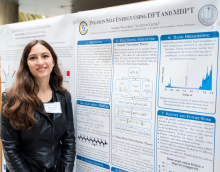
Major:
University:
Faculty Sponsor(s):
Faculty Sponsor's Department(s):
Project Title:
Project Description:
The development and construction of renewable energy sources is of ever-increasing importance. One aspect of this is sustainable energy storage, which is critical for intermittent sources such as solar panels and wind which cannot operate constantly due to environmental and geographic limitations. Current photovoltaic technologies increasingly rely on organic (semi)conducting materials due to their high versatility and tunability. The compound trans-polyacetylene is representative of a typical polymer exhibiting all hallmarks of charge transport in organic semiconductors: it can become highly conducting when strongly doped, as much as one charge per repeating unit. Charges added to polymers such as trans-polyacetylene form polarons, a spontaneous localization of electronic states, and a corresponding shift in surrounding nuclear coordinates. The formation of such additional excitations coupling the electronic states with the underlying lattice impacts the properties of the system. A theoretical description of the quasiparticle energies of polarons in compounds such as trans-polyacetylene would allow for calculation of electron and hole spectra and thus prediction of charge transport properties. We aim to describe polaron formation in trans-polyacetylene at various dopant concentrations ranging from 15 to 100 mole percent per repeating unit using the Quantum Espresso software implementation of Density Functional Theory (DFT). Then we will use advanced stochastic many-body perturbation theory (MBPT) to compute quasiparticle self-energies and spectra. From this, quasiparticle stability, localization and trapping effects, and transport properties can be studied. In future work, the same methodology will be applied to more complex polymer systems to predict these properties.
